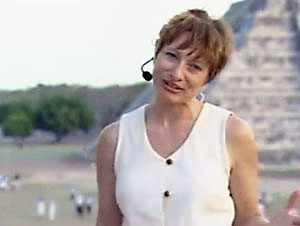 I had the privilege this week of interviewing Isabel Hawkins, an astronomer and director of the Center for Science Education at Berkeley's Space Sciences Laboratory. We talked about how people use evidence in science, how it is that we know what we know.
I had the privilege this week of interviewing Isabel Hawkins, an astronomer and director of the Center for Science Education at Berkeley's Space Sciences Laboratory. We talked about how people use evidence in science, how it is that we know what we know.
Hawkins isn't your ordinary astronomer. She began her career in an ordinary way: Ph. D. in Astronomy from UCLA, using mathematical models and computer simulations to give meaning to her observations. Along the way, she began to learn about how ancient people studied the sky. She's worked with us on our Ancient Observatories website, and hosted an equinox webcast from the top of the Mayan pyramid in the ancient astronomical site of Chichen Itza. And she's devoted a considerable amount of time and energy to understanding and appreciating how the knowledge of ancient people complements what modern scientists study today.
Most scientists today don't learn much about ancient knowledge. Observations such as measurements of the sun's movement across glyph-crusted temples don't usually meet the rigorous criteria of the scientific process: observe, create hypothesis, test, reproduce results.
In some instances, ancient people followed similar practices that were very similar to those used by modern scientists, observing things systematically and trying to devise explanations that will result in correct predictions. And sometimes the knowledge they gathered was, in fact, so "scientific" that modern researchers use it in their work today.
Take, for example, the knowledge of the Aymara Indians in Peru. The well-being of these adept weather-watchers was dependent on knowing how to time the planting of their vital potato crop with the arrival of the season's first rains sometime between October and December. They did this by making observations like meteorologists might today. They watched the Pleiades, or Seven Sisters constellation rise each night, and noted how fuzzy or clear it looked in the sky. Fuzziness caused by cirrus clouds high in the sky, meant rains were a ways off, and potato planting should be postponed. A clearly visible set of Sisters meant rains would come soon.
